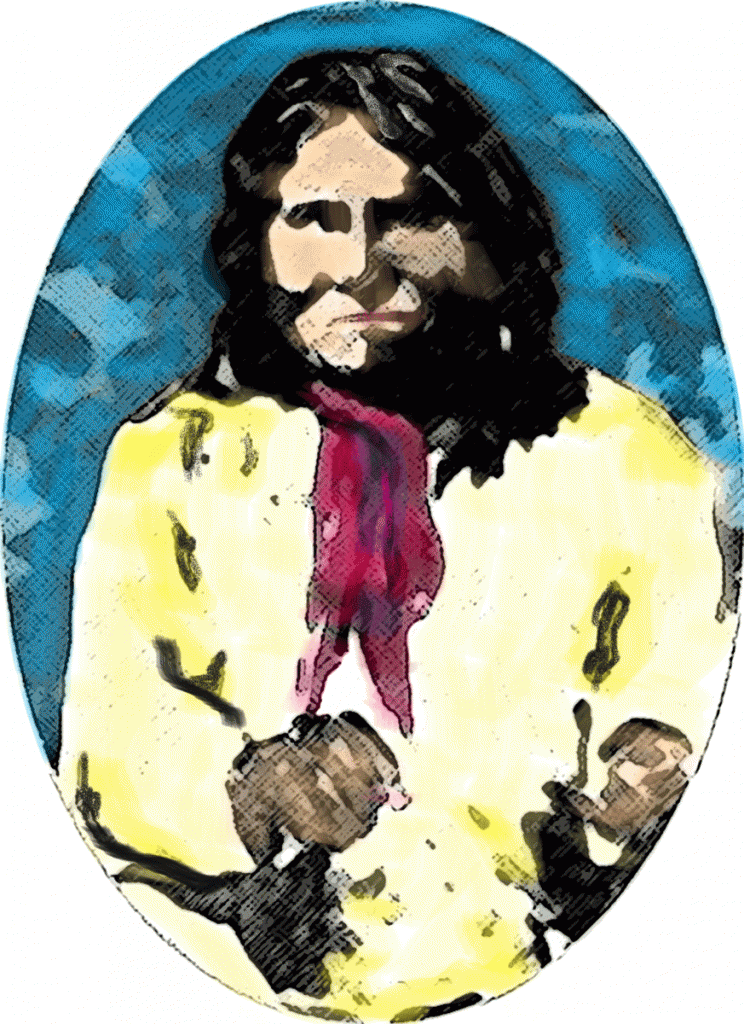Website & blogs © Louis Kraft 2013-2020
Contact Kraft at writerkraft@gmail.com or comment at the end of the blog
I know that my mind meanders all over the place. Unfortunately all the time. …My lady and my daughter always head the list—always.
Currently Gatewood and Geronimo dominate. I’ve got what I consider a major talk on them approaching quickly. Way too quickly. If you knew how I approach talks and prepare for them you’d have a major heart attack.
Artwork in progress of Geronimo (left). … I want to mention a person I met earlier this year (long distance) who is a filmmaker/director. His name is Dustinn Craig. In 2009, PBS Home Video released We Shall Remain: America Through Native Eyes, a collection of five documentary films. Dustinn directed Geronimo. It is a good film (let me repeat this: It is a good film.). He is currently working on a film that deals with White Mountain Apache scouts, and has kindly shared over 20 minutes of film with me. All I can say is, “Wow!” If his final film matches what he currently has, it is going to be extraordinary. Unfortunately I don’t have any images of Dustinn to share but hope to someday, for I know that I’ll be speaking about him in the future. Dustinn has shared great information with me that is his copyrighted data that he doesn’t want shared. I certainly understand and agree with this. He has also pointed out to me that Geronimo is not a hero among many Apaches (and Dustinn has an inside track for he is a White Mountain). Dustinn, thank you for a point well-noted. (art © Louis Kraft 2013)
‘Course, Mr. G. is my guy, and has been since I discovered him in the mid-1990s. No one—no one—compares to him. Not Black Kettle, not Roman Nose, not Tall Bull. Yep, all Cheyennes. That must tell you something about me and my close connection to the Cheyennes (they’re special). Let’s not forget Bull Bear, Little Robe and others, … and definitely include Mo-nahs-e-tah (how her name is phonetically spelled, and it is about time people begin pronouncing her name correctly).
Before moving on, I want to make one thing clear—the Apaches are also special. And the leader of the pack is Mr. G.
Names and how they are pronounced
I need to speak about Mo-nahs-e-tah, and I will soon. Count on it!
Most of you pronounce my name correctly. A few of you don’t, and I don’t think you have speech impediments.
My name is “Louis” and not “Louie” or “Luis.”
I take offense when people who are supposedly my friends
mis-pronounce my name on purpose. It isn’t because their
tongues don’t function, it is because they have no respect.
Maybe I should begin calling them “Sissy-poo.”
Geronimo: An American Legend

Geronimo (Wes Studi) and Lt. Charles Gatewood (Jason Patric) await the approaching Tombstone posse (read: lynch mob). Geronimo wants Gatewood’s binoculars as they are better than his and offers a turquoise rock (valuable to the Apaches). They are about to shoot at the approaching Tucson posse, and it is Geronimo’s first shot that wins the day. Although I hadn’t thought about it, this scene actually is the backbone to the Geronimo article I’m trying to create at the moment. This event never happened in Geronimo’s life, so I’m not reveling much here. This is a German lobby card from Geronimo: An American Legend (1993). The Germans do much better film publicity than the USA does, and they’ve doing this since the late 1940s. … Anyway, a great scene that never happened in real life. (LK personal collection)
In December 1993 I saw Geronimo: An American Legend with Wes Studi playing Mr. G. and Jason Patric playing the other Mr. G. (Lt. Charles Gatewood). I liked the grandeur and scope but I hated the lack of character focus in the film. The writer(s) and director couldn’t figure out who the film was about. Worse—although I didn’t know this at the time—they decided that fiction was better than fact; too many people buy into this bullshit, including director John Ford. Ford supposedly said something like, “If you have the choice between fact and legend, print the legend.” At best, this quote is a paraphrase (at worse he never said it), for I made no attempt to confirm it. I don’t agree with Mr. Ford, for often fact is much more interesting than legend. That doesn’t mean that “legend” doesn’t play well on film.
The three best scenes in Geronimo: An American Legend are 1) When Geronimo and Gatewood shoot at the Tombstone posse at the beginning of the film, 2) Gatewood accepting an Apache warrior’s challenge and killing him in single combat, and 3) Gatewood’s shootout with scalp hunters in a cantina in Mexico (BTW, none of the people in the cantina scene were with Gatewood in Mexico in 1886). So what’s the problem? Just this: None of these events happened. Other than being perhaps 25 years too young, Wes Studi was perfectly cast as Geronimo while Jason Patric (as Gatewood) attempted to do a southern accent, but that was as far as his research went. And—AND—this film is total fiction in detail. If you buy any of this film and cite it, you’ve made a major error. End of subject. Again, per John Ford, let’s print the legend!!!! My humble opinion, pure bullshit for the simple reason that (at least in this case) reality is much-much more dramatic than fiction.
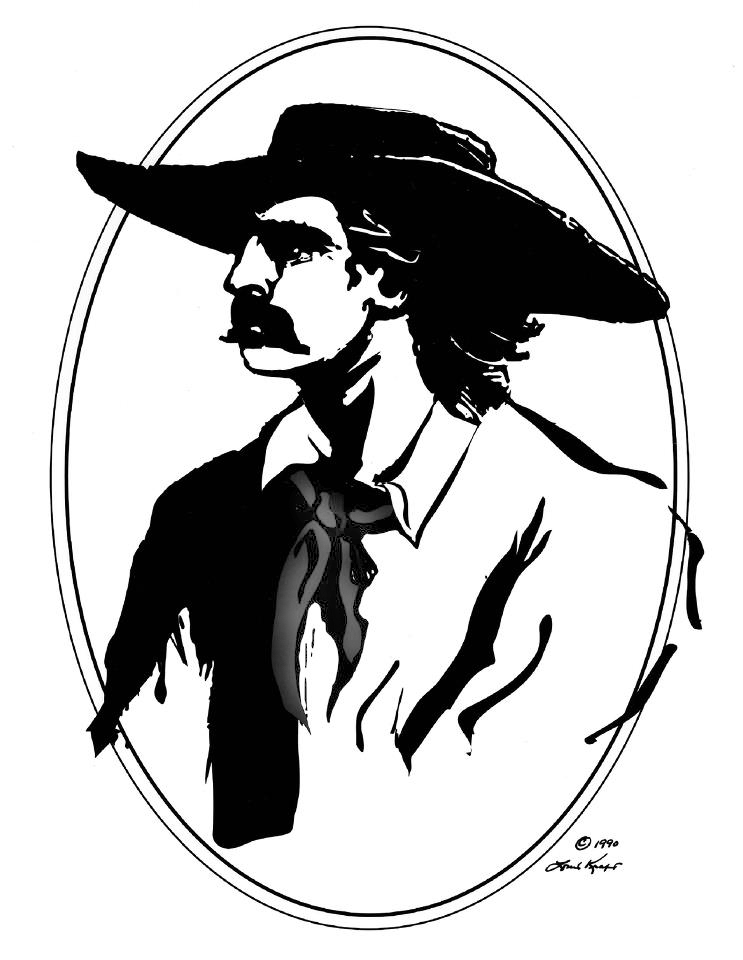
Ned Wynkoop in 1867. Originally in Custer and the Cheyenne, published by Upton and Sons in 1995. (art © Louis Kraft 1990)
Not quite end of subject: George Armstrong Custer died at the Battle of the Little Bighorn in 1876. Any film or book that has him surviving that battle is bullshit, … it is not printing the legend. Ned Wynkoop did not participate in the massacre of Cheyenne and Arapaho Indians at Sand Creek in 1864. Any film or book that places him at that tragical event is bullshit. A major miniseries of a few years back did exactly this. An historian/professor and a friend of mine justified this—he claimed that the merging characters and placing a real person in an event that he had nothing to do with is fair game. NOOO!!! YOU CANNOT TAKE A REAL PERSON AND PLACE THEM IN AN HISTORICAL EVENT THAT THEY DIDN’T PARTICIPATE IN. THIS IS NOT CREATIVE LICENSE, AND IT SURE AS HELL ISN’T PRINTING THE LEGEND. ALL IT DOES IS CREATE FALSE HISTORY THAT WILL EVENTUALLY BECOME REALITY AND CITED AS TRUTH IN THE FUTURE. I’m sorry folks, but this is a sore point with me. Let’s put it another way, I hate lies and I hate liars. As a filmmaker, historian, novelist, or playwright you can deal with Wynkoop and the events surrounding Sand Creek and Custer and the march to Little Bighorn and the battle that resulted in his death, but you cannot place Wynkoop at Sand Creek and you cannot have Custer survive Little Bighorn and make it appear to be truth.
Have any of you heard a recording of Orson Welles’s great 1930s radio
broadcast of a Martian invasion of earth? Even though the radio station
advertised that the dramatic presentation was fiction,
supposedly people committed suicide.
True? I don’t know.
Certainly the Wynkoop and Custer inaccuracies have happened in film and in fiction. Did the filmmaker or the novelist point out the untruth to the facts presented? The filmmaker didn’t (I haven’t watched any of his produced or directed films since and have no intention of watching any in the future). I’m too far removed from the novel (by the great western novelist Douglas C. Jones), but think Mr. Jones made it clear that his story was a “what if.”
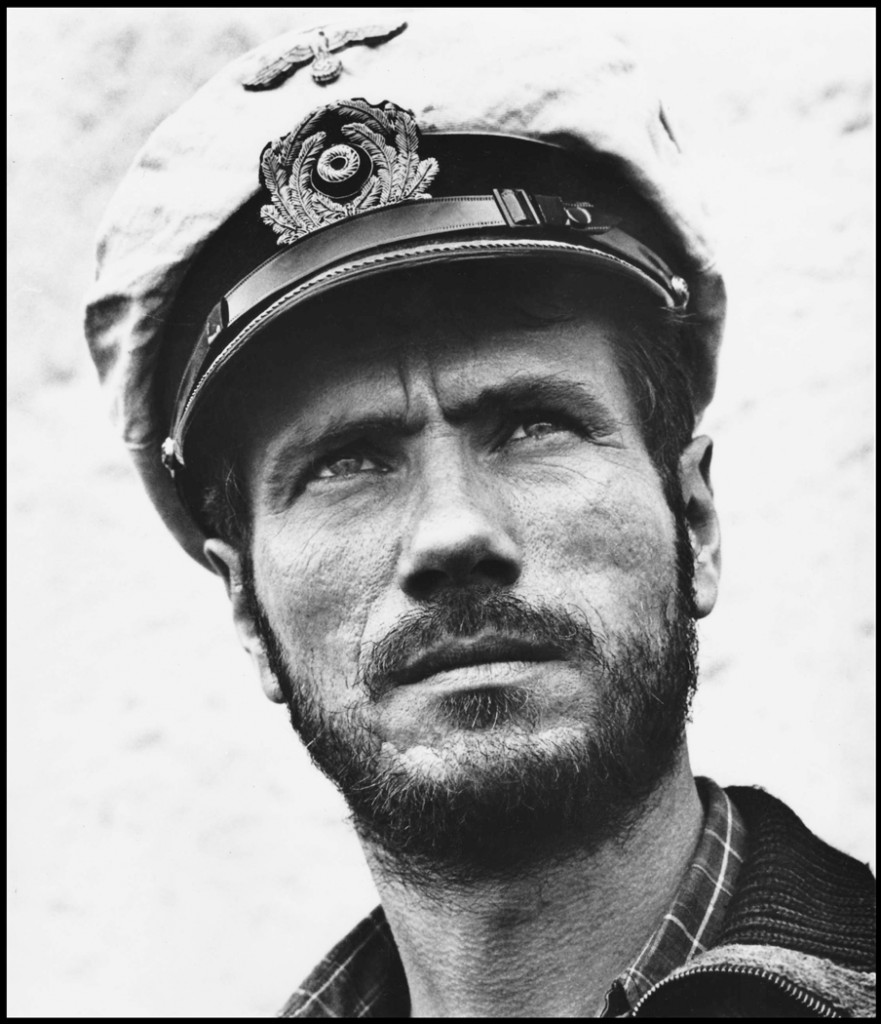
Jurgen Prochnow played the U-boat commander of U-96 in Das Boot (1982). Simply put, this is a great anti-war film, and Prochnow’s performance was under-played brilliance. I’ve seen him in a number of American films, and unfortunately the parts weren’t right for him. Like The Searchers, Das Boot is one of my favorite films. Das Boot differs from my “Wonder-boat” screenplay in that it details a single U-boat voyage while the screenplay had a larger scope. I hadn’t been aware of the film until touring The Prince and the Pauper in Northern California. I was living on the east side of San Francisco Bay when the film was released and saw it immediately. My agent loved “Wonder-boat” but had told me it was unsellable because of the subject matter. As soon I returned to LA I fired him. (Louis Kraft personal collection)
I read a great novel about 30 years ago that had Hitler survive WWII and become a model citizen. Great story telling. However, as soon as I finished reading the book (I don’t remember the author or the title of the book) I donated it to Vietnam Vets. Why? What if this is all someone reads about Adolph Hitler? They will think that he was a good person who had been maligned. No! No! He stood for genocide of races of people. This can never be condoned.
I’m not picking on Germans here. The best screenplay I ever wrote dealt with the destruction of Germany as seen through the eyes of a U-boat commander (who wasn’t a Nazi—many Germans were not members of the Nazi party) who was in love with a Jewish woman. It was a tragedy, for the simple reason that WWII resulted in horrific consequences for the German people, many of whom had nothing to do with the heinous crimes committed by Hitler’s regime.
Let me put this another way. If someday a writer/historian places me at the My Lai Massacre during the Vietnam war, he or she would be in error for I have never been to Vietnam. Moreover, if I had been present when that heinous crime happened, I would not have survived (and you can guess why). … I should add this, if a writer does get creative and places me at My Lai, he or she had better disappear pronto! For as Kurt Russell (playing Wyatt Earp) said in Tombstone (1993), “Hell is comin’!”
The bottom line (and this unfortunately includes nonfiction books) is that untruths and out-and-out lies become truths.
A John Ford opinion
John Ford made one great western, The Searchers (1956) with John Wayne and Geoffrey Hunter, and one good western, She Wore a Yellow Ribbon (1949) with John Wayne. I’m not going to comment about any of Ford’s other western films, including Stagecoach and Fort Apache. My silence should give you a good guess of what my less than sparkling views of his western films might be. I have nothing further to say about Ford’s westerns, other than to say I’m certain I’ll not see any of them again, other than The Searchers and She Wore a Yellow Ribbon. Why waste my time?
The Searchers is one of my favorite films.
John Wayne’s performance is extraordinary and will hold up for all time.
Why Gatewood & Geronimo?
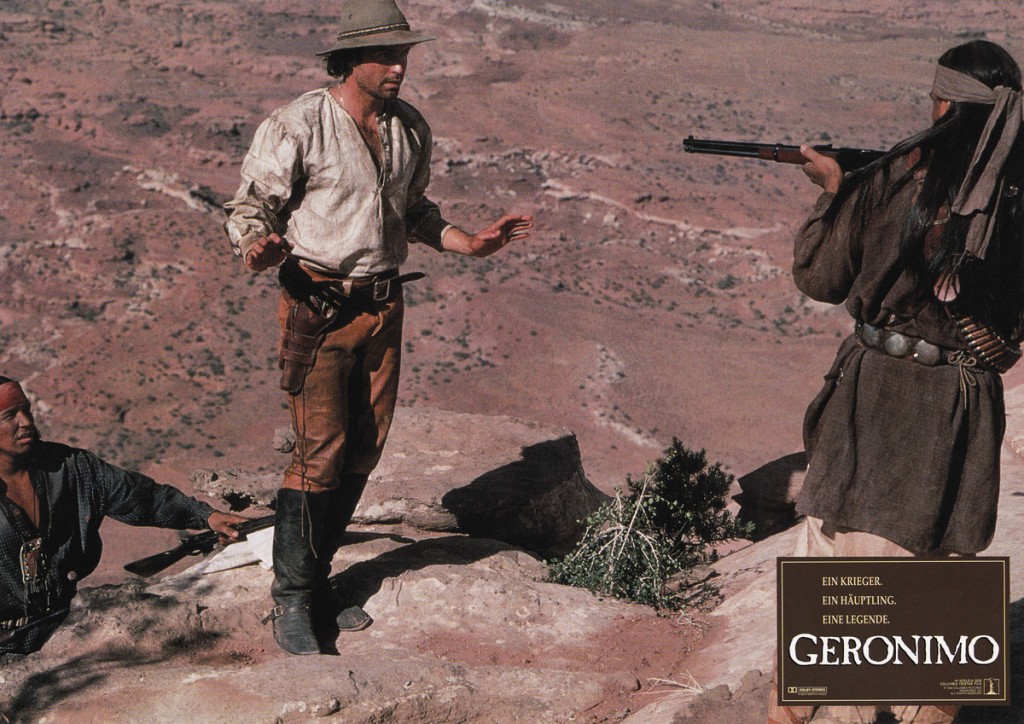
On August 25, 1886, Lt. Charles Gatewood negotiated ending the last Apache war with Geronimo and Naiche. This scene, from Geronimo: An American Legend (1993) is totally wrong. Gatewood (played by Jason Patric) has climbed up to Geronimo’s stronghold. One problem: Geronimo insisted upon meeting at a bend of the Río Bavispe where there was shade, grass, wood, and water. Do you see any of this here? Of course not! Also, note that Chatto (as played by Steve Reevis) is just reaching the top of the mount. One problem: Chatto wasn’t with Gatewood in Mexico in 1886, while Naiche, the last hereditary Chiricahua Apache chief was and he isn’t in the film. Again, another great German lobby card for the film. (LK personal collection)
In 1995 I signed copies of Custer and the Cheyenne at Guidon Books (my favorite bookstore) in Scottsdale, Arizona. BTW, Aaron and Ruth Cohen, who owned and ran Guidon Books, played a major role in my Indian wars writing life.
On that 1995 day Ruth started a conversation dealing with recent films and how they impacted book sales. Tombstone with Kurt Russell as Wyatt Earp and Val Kilmer as Doc Holliday had been a hit and greatly influenced book sales while Geronimo: An American Legend had not done well at the box office and didn’t influence book sales. Since I wrote about race relations and the Indian wars our talk focused on the Geronimo film.
Bro Glen Williams took this photo at the AHS in February 2012 (photo © Louis Kraft & Glen Williams 2012)
I told Ruth and Aaron that all I knew about Charles Gatewood and Geronimo was what I saw in the film. Ruth told me that the Arizona Historical Society (AHS) in Tucson housed the Gatewood papers. Even though I wasn’t thrilled about the film (I had seen it twice in theaters), the story had grabbed my interest. I needed to know more, and at this point I had no idea what the truth might be. At that time I wrote for a telecommunications firm in the South Bay (in SoCal). The following month I took a week off, drove to Tucson, and began to explore Gatewood and his world at the AHS. I couldn’t believe what I saw. Suddenly Gatewood became my next nonfiction book project. After a very rough first draft I realized something was missing. I thought for a week, maybe two. It hit me: Gatewood needed Geronimo. Suddenly the book had focus.
| Custer and the Cheyenne put me on the nonfiction map and opened doors, but it was Gatewood & Geronimo that changed my presence in the Indian wars writing world. It made me a player and gave me name recognition. Dick and Frankie Upton at Upton and Sons and Durwood Ball, then editor-in-chief at the University of New Mexico Press, are probably the three most important people in my nonfiction Indian wars writing life. If it wasn’t for them I’d probably still be floating in a dark netherworld fighting to sell my nonfiction book ideas. Dick and Frankie were already friends, and soon Durwood a friend. My “thank you’s” are usually quiet when they should be public. Frankie, Dick, and Durwood—thank you. |
I wrote roughly two-thirds of the words in Lt. Charles Gatewood & His Apache Wars Memoir (2005). About a month and half before publication date, Mr. Big Shot (notice that I didn’t call him Mr. Big Shit) at the University of Nebraska Press decided to change credits, thinking correctly that I wouldn’t walk (as I could have due to the contract). Obviously my anger still seethes. So be it! Here are the facts, other than the U of NE Press formatting some of my words at the beginning of the book so that they appeared as if Gatewood wrote them, and even with the nasty contract crap at the midnight hour, this book is by far my best selling book (and I’m proud of it, even though I’ll never write another word for Nebraska). Actually, I love it when Gatewood gets great reviews for his writing skills. Without bragging, I hacked the hell out of the lieutenant’s passive text that included 100-word sentences and paragraphs that easily flowed over pages. A few years back my good friend Greg Lalire, editor at Wild West magazine, called me and said that Gatewood’s words in the Memoir didn’t match his words at the AHS. “Greg,” I said, “did you read the introduction to the Memoir, which makes it clear that I edited Gatewood’s passive words?” “I did! I forgot. Sorry,” Greg said. Ladies and gents, let’s put it this way. Charles Gatewood had a great story to tell; he just didn’t know how to do it. I helped him. BTW, I think this dust jacket is cool. Love it!
That land of snow they call Colorado
In April 2013 I spent 11 days in this falsely advertised wonderland of 300 days of sunshine (Colorado). During my last two trips to this sun-filled salesman’s pitch I’ve been snowed in.
If you want to see 300 days of sunshine, real 300 days of sunshine, visit SoCal. You want to see snow with no visibility, visit Colorado.
It wasn’t that many years ago that Colorado (read Denver), was a possible place for me to live. Colorado has great history (love it!), great people (love them), but 300 days of sunshine? Hell! You want the truth? I’ve got some ocean-front property in Arizona that I can sell to you at a reasonable price.
Layton Hooper and his wonderful wife Vicki (right) in their backyard in Fort Collins, Colorado. They kindly put me up for 11 days in April 2013 when I visited the land of snow to give a Wynkoop talk for Order of the Indian Wars (OIW) symposium and do Sand Creek research. Although snow storms eliminated much of my research time, it gave me the bonus of getting to hang out with Layton and Vicki and getting to know them. They were perfect hosts, making me feel welcome at all times. This image was taken fairly early on one of the mornings after the second snow storm had passed. To this point in time I didn’t have any photos of Vicki, and she kindly agreed to put on a coat and step outside with her hubby. … Layton is one of the key players in the OIW, and will be one of the leaders on the tour tracking Geronimo September 27-29. (photo © Louis Kraft 2013)
What is a talk?

LK speaking at the Festival of the West in Scottsdale, Az., on 19mar2005 (photo by Johnny D. Boggs and © Louis Kraft & Johnny D. Boggs 2005)
A long diversion to get to this point. Sorry. More importantly why am I talking about Gatewood and Geronimo? I haven’t spoken about them in years. My first talk was about Ned Wynkoop back in the mid-1980s, and I have continued to talk about Ned. That said, believe it or not, it wasn’t until 2011 or 2012 that I actually spoke about Ned more often than I did about G&G. Yep, I gave a lot of talks about them. But it ended when the Wynkoop book became reality. So why return to Mr. G. and Mr. G.?
Ned Wynkoop dominated the 1860s, even though the press, the military, and the government did everything possible to relegate him to the circular file. Why? Simple. He didn’t kiss their asses, and dared to speak out against what he considered the wanton murder of human beings—human beings that weren’t white.
The Gatewood character in Geronimo: An American Legend says, “The Apaches are special.” And they are!
Mike Koury has been a friend since the 1980s. He has done whatever he could to help. When I visited the land of snow last April I spent a morning and afternoon with Mike. We lunched with his pretty wife Dee and hung out in his library/computer room. Good time. On that day I pitched Mike to talk about Gatewood finding Geronimo in Mexico for his Order of the Indian Wars event in Tucson in the fall. I did this for one reason, and one reason only. Mike is one of those people who believes that the Indian wars begin and end with the Plains Indian wars. My sole goal for speaking in Tucson is to wake Mike up to the fact that the Apache wars are exciting times with much at stake (just like the Plains Indian wars).
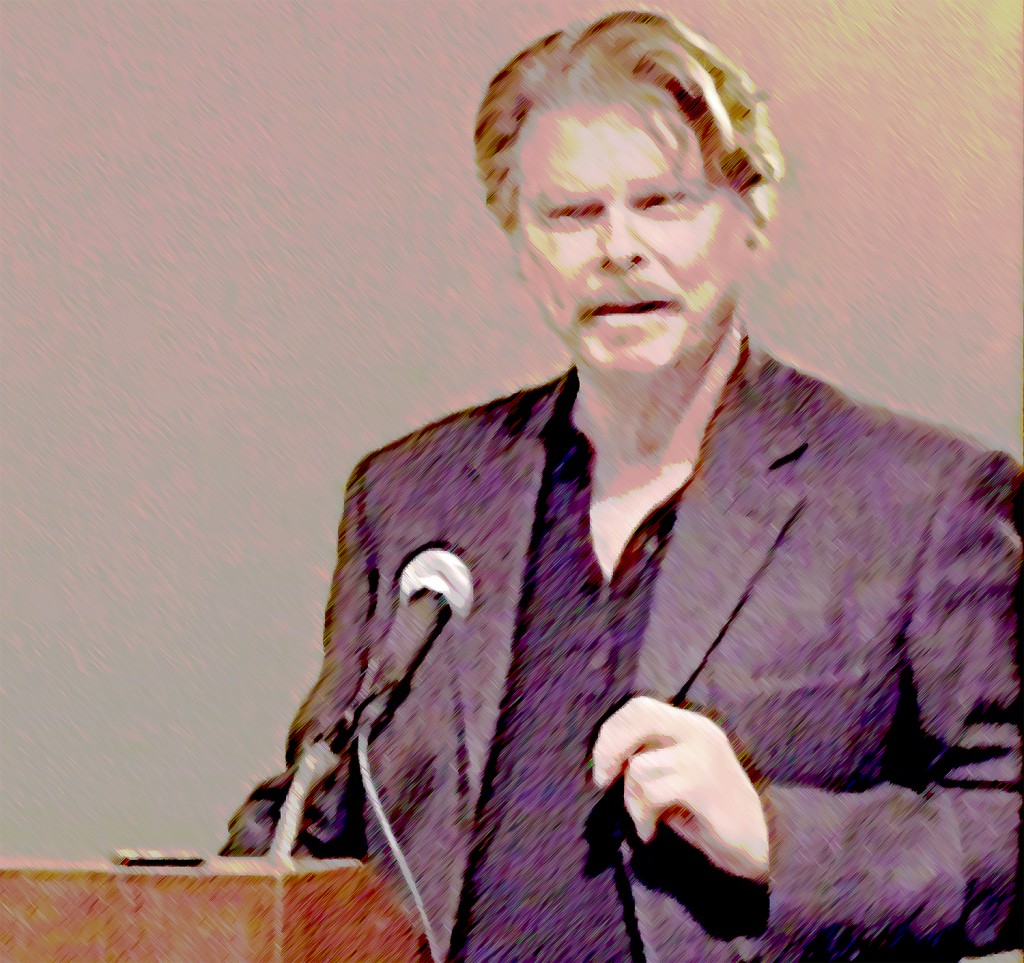
LK speaking at one of Dick and Frankie Upon’s symposiums in El Segundo, Ca. (art © Louis Kraft 2012)
Mike gave me a thumbs up.
My goal on September 26 is to get my facts as good as possible and not to put Mr. Koury to sleep.
Actually this has always been my goal when talking: Get the facts right and don’t put anyone to sleep.
I like giving talks. Actually, I like it a hell of a lot better than writing magazine articles. I like the one-shot to be good, boring, or deadly. There are no holds barred. It is one on one times X. The key is concentration, … preparation, relaxation, focus, and more concentration. Of course there are always “chilly twitching movements,” to quote Gatewood when he met Geronimo in Mexico and demanded his surrender. But they’re fleeting. There is a rush, an exhilaration, and a zone. When I enter this “zone,” it is another world. The only other thing that approaches this live thrill is performing on the stage (actually I like the stage better). A talk is a one-shot performance. Whatever happens can’t be changed.
Good progress on the G&G talk, but YIKES I’ve got to complete that damned Geronimo article for Wild West. Enough!

